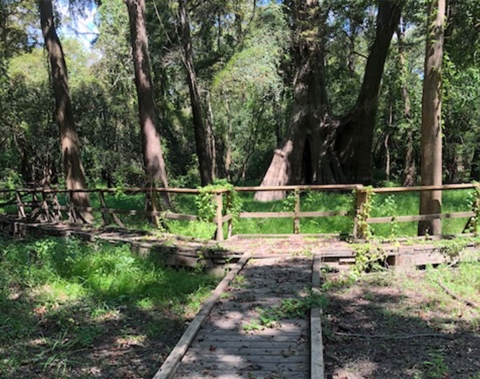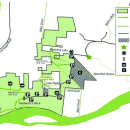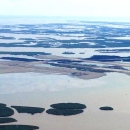Visit Us
Cat Island National Wildlife Refuge is located in St. Francisville, Louisiana, approximately 30 miles north of Baton Rouge. The refuge’s sloughs and ponds, bottomland hardwood forests, and cypress-tupelo swamps offer abundant food resources for wading birds, a stopover for migratory waterfowl, and habitat for deer and many other native species.
Know Before You Go
Cat Island National Wildlife Refuge consists of 10,973acres. We strongly recommend you do not rely on an electronic navigation device to find your way around the refuge. Inaccurate maps and limited reception can lead you astray.
There are no facilities on Cat Island National Wildlife Refuge. Roads are generally passable in a 2-wheel drive vehicle, but are in primitive condition.
The refuge is located along a large bend in the Mississippi River and is periodically flooded by the Mississippi. The refuge may remain flooded for several months of the year, with flooding typically starting in December and ending by June. When river levels rise or are expected to rise, refuge access may be limited or closed due to flooding or threat of flooding. Refuge access becomes questionable when the Mississippi River is rising and reaches 20’ on the Baton Rouge gauge. Check this website for alerts before you go.
Check weather.gov for current river stages
For visitor information, pay a visit to the St. Francisville Historical Society at 11757 Ferdinand Street in St. Francisville, Louisiana 70775. Visitor maps are also available at the entrance to the refuge.
How to Get There
Note: We recommend that you do not rely on an electronic navigation device to find your way around the refuge. Inaccurate maps and limited reception can lead you astray. From Natchez, MS: From U.S. Highway 61S, turn right onto Highway 66 and turn left (west toward Angola). Continue 1.5 miles, and turn left on Solitude Road. Continue approximately 3.5 miles, and turn right at the refuge sign. Continue another 1.5 miles to the refuge entrance.
From St. Francisville, LA: From Commerce St. take Ferdinand St. one mile and take a right on Mahoney Rd. Go three miles, cross the low-water crossing bridge and take a left on Creek Rd. Take a slight left to stay on Creek Rd. Creek Rd continues to the Cat Island NWR Entrance. Be aware that this route may not be accessible when river levels are high.
Activities
The refuge is popular for big and small game hunting - deer, squirrel, rabbit, waterfowl and woodcock. Feral swine may be taken with legal firearms or archery equipment during any open hunting season. The refuge is known for its abundant squirrel population. Hunters often report that they can easily harvest a bag limit within 30 minutes due to the many squirrels on the refuge.
The refuge is open for fishing year-round subject to the state of Louisiana fishing regulations. The Mississippi River is a popular fishing spot for bank anglers. The refuge offers fishing on three ponds, which are open year-round when the refuge is open.
Bird watchers, photographers, and other visitors may enjoy the refuges' Big Cypress hiking trail where you can enjoy a walk to view a champion bald cypress tree, reported to be one of the largest trees of any species east of the Sierra Nevada. The fall and spring migrations bring many songbirds and wading birds to the refuge. Summer months are a good time to observe large numbers of wading and shorebirds. Be on the lookout for wading birds, turtles, and alligators as you drive along the refuge road. You may also explore Cat Island by canoe, kayak, or other hand-launched boats.
Trails
Hiking Trails
The refuge has two hiking trails which are solely open to hikers and non-motorized access, and are closed to hunting. The most popular and easiest hike is the Big Cypress Trail which goes to a giant bald cypress tree. This flat.75-mile round-trip hiking trail is located 4.6 miles from the main gate. This easy trail winds through a bottomland hardwood forest leading to an impressively large bald cypress tree estimated to be about 1500 years old. At a height of 96 feet, a diameter of 17 feet, and a circumference of 56 feet, it is truly a sight to behold.
The 2.5 mile-long Blackfork Trail winds through an old-growth cypress forest. This relatively flat, easy trail is marked by white diamonds. and is located 1.7 miles from the main gate. This scenic trail splits around a short loop following Blackfork Bayou and winds through a spectacular old-growth cypress forest. The Blackfork trail was created and is maintained by volunteers from the Louisiana Hiking Club.
ATV/UTV Trails
ATV/UTVs may only be used for hunting or fishing access purposes. Three ATV trails are open to all users and are frequented by hunters and anglers. ATVs and UTVs must stay on designated roads and trails, and may not ride off-trail. To prevent resource damage, ATVs/UTVs may not ride on flooded roads or flooded trails on the refuge.
Wood Duck Trail: This 2.5-mile-long trail is frequented by anglers and hunters. Two borrow pits adjacent to the trail provide great fishing for freshwater species (white perch, etc.). This is a popular hunting trail for squirrel and small game hunters.
Riverside Trail: 2.0 miles. This trail parallels the Mississippi River. ATVs are allowed on entire trail, but flooding can create accessibility issues. There is a bridge that limits ATV access approximately 3/4 mile down the trail. From that point forward access is by foot only.
Blue Goose Trail: 1.5 miles. This trail is primarily used by hunters. ATVs are allowed on the first 3/4 mile of the trail. The remainder of this trail is wet year-round and skirts along a ditch.
See below for trail maps
Related Documents
Other Facilities in the Complex
Cat Island National Wildlife Refuge is managed as part of the Southeast Louisiana National Wildlife Refuges Complex. The Southeast Louisiana Refuges are part of a rich ecological system which includes marshes, pine and bottomland hardwood forests, lakes, barrier islands, swamps and bayous. Ranging from the marshy delta at the mouth of the Mississippi, to the wetlands that help protect New Orleans from hurricanes and provide a nursery to the fisheries that support the region’s food economy, to the wild bayous of the Atchafalaya Basin; your Southeast Louisiana National Wildlife Refuges preserve wildlife, habitat, and recreation opportunities representative of this unique part of the country.
All of the Southeast Louisiana National Wildlife Refuges are open to public visits for nature-based recreational enjoyment. Priority public uses are hunting, fishing, wildlife observation, wildlife photography, environmental education, and interpretation.
The refuge complex headquarters is located at 61389 Hwy 434, Lacombe, Louisiana 70445. This site also hosts the Bayou Lacombe Visitor Center and has walking trails that wind through an historic garden site and along Bayou Lacombe.
Rules and Policies
Enjoy exploring and recreating in your National Wildlife Refuge. The refuge is open from sunrise to sunset. (Special times for hunters in season).
Closures
Refuge roads may be closed to public entry due to flooding. Be aware of signs indicating closed areas. The two designated hiking trails (Big Cypress and Blackfork) are closed to all hunting. ATVs and UTVs may be used for hunting and fishing access only, must stay on designated roads and trails, and may not ride on flooded roads or trails on the refuge.
General Regulations
To ensure healthy habitat and sustainable natural resources for your continued enjoyment, and to ensure visitor safety, the following are rules and prohibited activities:
- ATVs and UTVs may be used for hunting and fishing access only, must stay on designated roads and trails, and may not ride on flooded roads or trails on the refuge.
- The use or possession of alcoholic beverages while hunting is prohibited.
- Non-toxic steel shot must be used in shotguns.
- Fires and camping are not allowed on the refuge.
- Possession or distribution of bait while in the field and hunting with the aid of bait, including any grain, salt, minerals, or any non-naturally occurring food attractant is not allowed.
- Cutting, removing, or damaging vegetation is prohibited.
- It is illegal to operate drones-unmanned aircraft on refuge property without a special permit. (*A drone flight may be permitted occasionally for research or resource management purposes). If a drone operator stands beyond refuge boundaries and flies the vehicle over the refuge, fines can be levied if the drone is observed disturbing wildlife.
- Searching for or removing any object of archeological or historical significance, including arrowheads, pottery, etc., as well as any natural materials such as plants, mushrooms, berries, and antler sheds is prohibited.
Non-emergency complaints of violation on refuge lands should be reported to Refuge Law Enforcement, (985) 882-2041.
To report general wildlife violations in the State of Louisiana: Louisiana Department of Wildlife and Fisheries Operation Game Thief Hotline: 800-442-2511.








